Abstract
Much research in the pathophysiology of gall stones has been devoted to various molecular species of bile salts. Recent findings have shown the importance of phospholipids in biliary pathophysiology. In the present study the addition of increasing doses of egg lecithin to human and model biles progressively prolonged the nucleation time. Concurrently biliary cholesterol was shifted from the vesicular to the non-vesicular carrier(s) while the cholesterol/phospholipid ratio of the remaining vesicles was progressively lowered. Model bile solutions of identical lipid concentration were prepared using phosphatidylcholine, phosphatidylserine, and phosphatidylethanolamine as the only phospholipid. With phosphatidylethanolamine most of the cholesterol was shifted to the vesicular carrier while phosphatidylserine shifted most of the cholesterol to the non-vesicular carrier(s). With phosphatidylcholine the cholesterol was distributed in both carriers. Phosphatidyl choline species composed of various acyl fatty acids in the sn-1 and sn-2 positions were used as the sole phospholipid in otherwise identical model bile solutions. With palmitic acid in the sn-1 position and arachidonic acid in the sn-2 position most of the cholesterol was found in the non-vesicular carrier. When stearic acid was used in sn-2 position instead of arachidonic acid most of the cholesterol was found in the vesicular carrier. These and other variations in phospholipid molecular species shifted cholesterol among its carriers and also modified the nucleation time of model biles. Most of these effects were also found upon addition of the various phospholipid species to human biles. These findings show the importance of phospholipid species in biliary pathophysiology and may be useful when trying to manipulate cholesterol carriers and solubility in bile.
Full text
PDF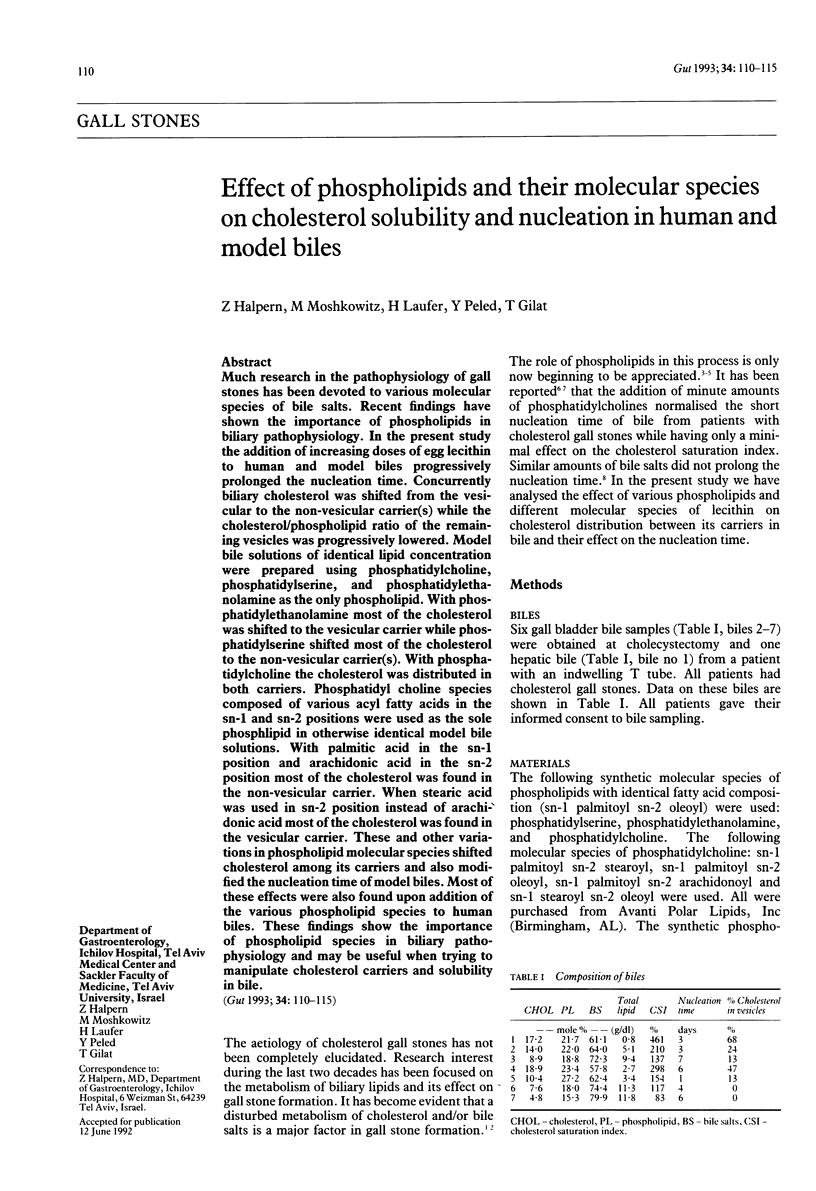
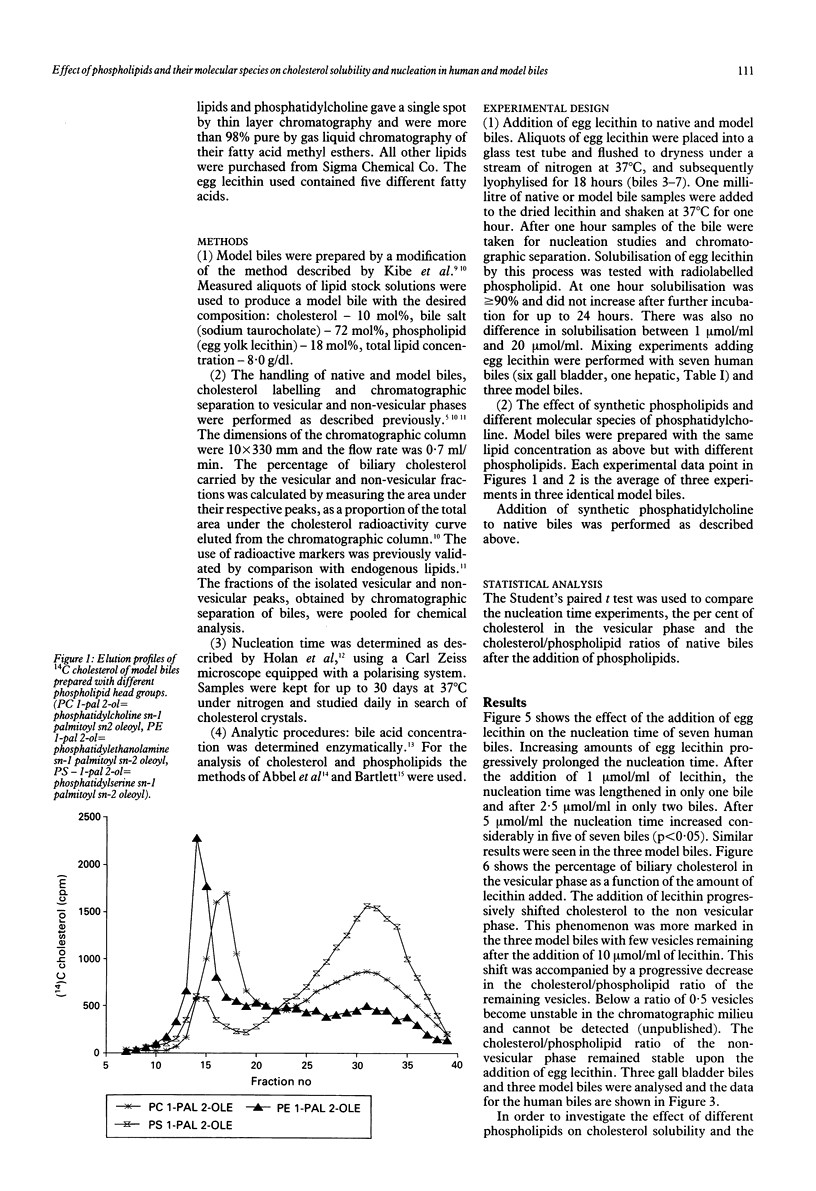
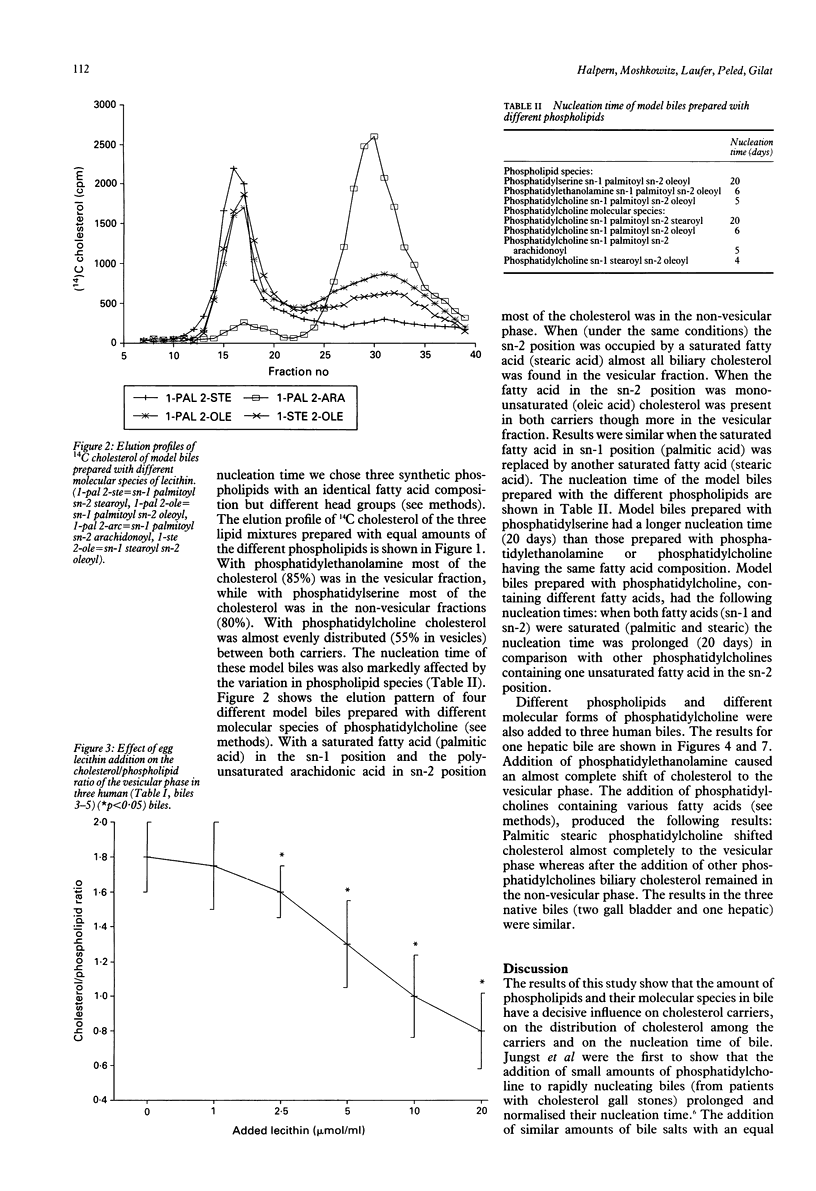
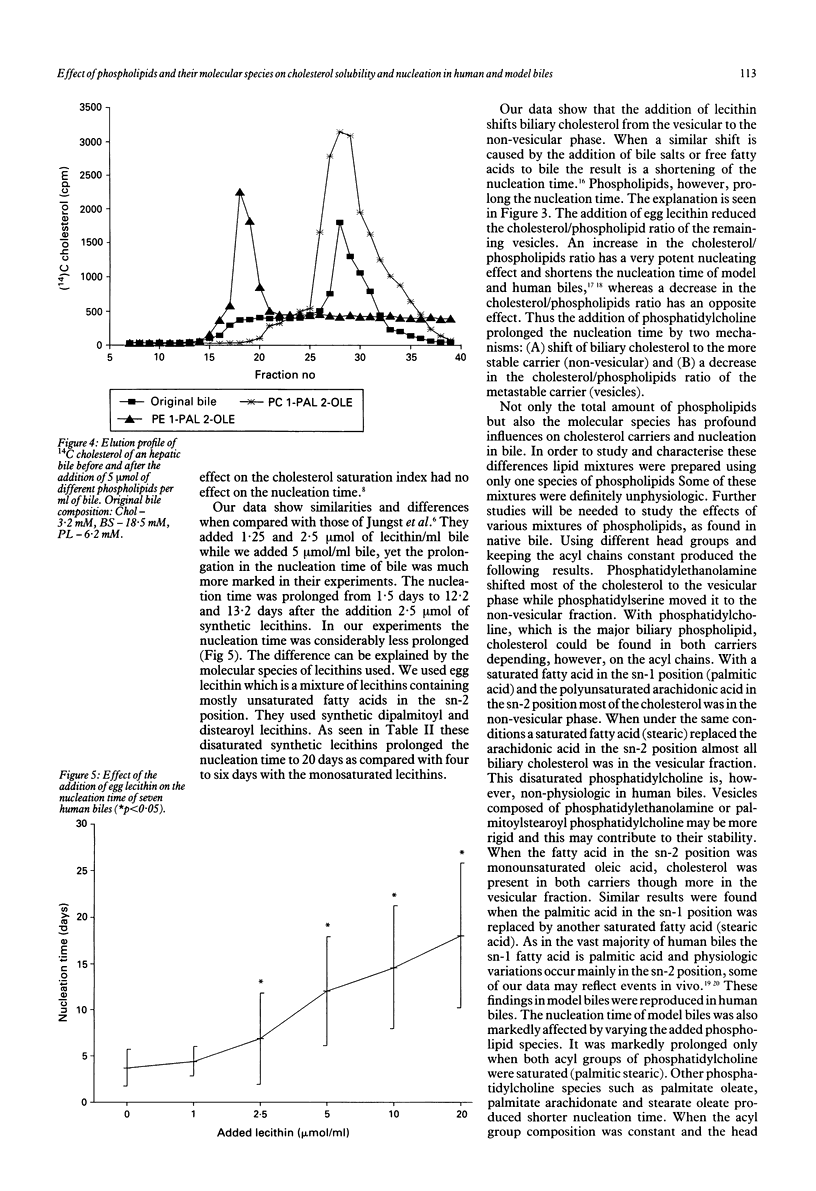
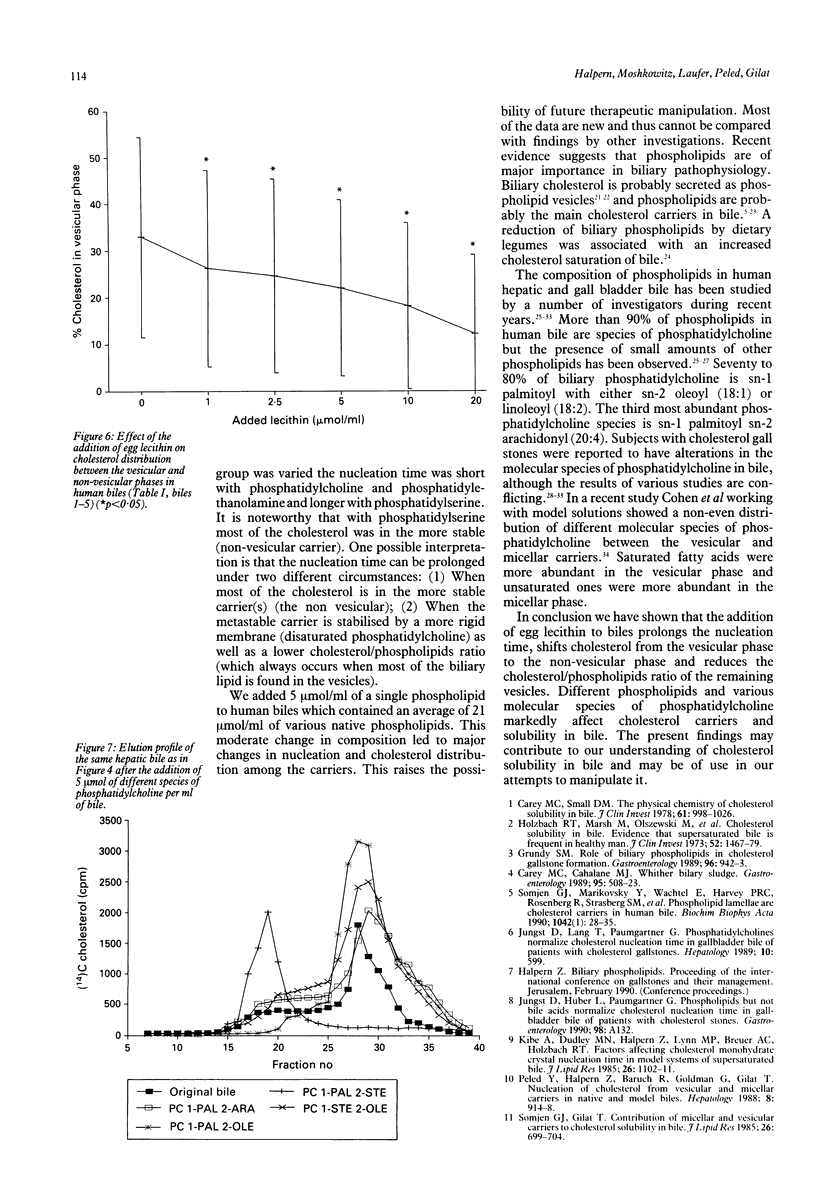
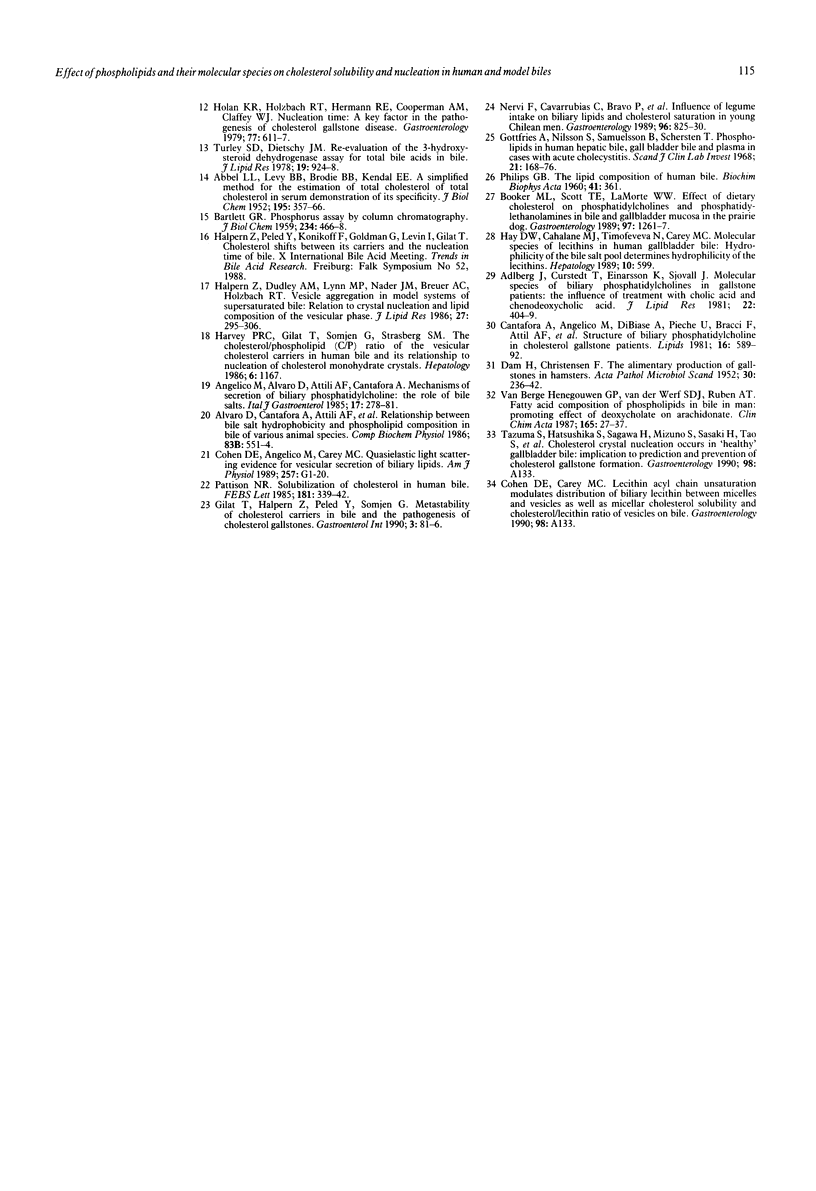
Selected References
These references are in PubMed. This may not be the complete list of references from this article.
- ABEL L. L., LEVY B. B., BRODIE B. B., KENDALL F. E. A simplified method for the estimation of total cholesterol in serum and demonstration of its specificity. J Biol Chem. 1952 Mar;195(1):357–366. [PubMed] [Google Scholar]
- Ahlberg J., Curstedt T., Einarsson K., Sjövall J. Molecular species of biliary phosphatidylcholines in gallstone patients: the influence of treatment with cholic acid and chenodeoxycholic acid. J Lipid Res. 1981 Mar;22(3):404–409. [PubMed] [Google Scholar]
- Alvaro D., Cantafora A., Attili A. F., Ginanni Corradini S., De Luca C., Minervini G., Di Biase A., Angelico M. Relationships between bile salts hydrophilicity and phospholipid composition in bile of various animal species. Comp Biochem Physiol B. 1986;83(3):551–554. doi: 10.1016/0305-0491(86)90295-6. [DOI] [PubMed] [Google Scholar]
- BARTLETT G. R. Phosphorus assay in column chromatography. J Biol Chem. 1959 Mar;234(3):466–468. [PubMed] [Google Scholar]
- Booker M. L., Scott T. E., La Morte W. W. Effect of dietary cholesterol on phosphatidylcholines and phosphatidylethanolamines in bile and gallbladder mucosa in the prairie dog. Gastroenterology. 1989 Nov;97(5):1261–1267. doi: 10.1016/0016-5085(89)91697-1. [DOI] [PubMed] [Google Scholar]
- Cantafora A., Angelico M., Di Biase A., Pièche U., Bracci F., Attili A. F., Capocaccia L. Structure of biliary phosphatidylcholine in cholesterol gallstone patients. Lipids. 1981 Aug;16(8):589–592. doi: 10.1007/BF02534904. [DOI] [PubMed] [Google Scholar]
- Carey M. C., Cahalane M. J. Whither biliary sludge? Gastroenterology. 1988 Aug;95(2):508–523. doi: 10.1016/0016-5085(88)90513-6. [DOI] [PubMed] [Google Scholar]
- Carey M. C., Small D. M. The physical chemistry of cholesterol solubility in bile. Relationship to gallstone formation and dissolution in man. J Clin Invest. 1978 Apr;61(4):998–1026. doi: 10.1172/JCI109025. [DOI] [PMC free article] [PubMed] [Google Scholar]
- DAM H., CHRISTENSEN F. Alimentary production of gallstones in hamsters. Acta Pathol Microbiol Scand. 1952;30(2):236–242. doi: 10.1111/j.1699-0463.1952.tb00179.x. [DOI] [PubMed] [Google Scholar]
- Gottfries A., Nilsson S., Samuelsson B., Scherstén T. Phospholipids in human hepatic bile, gall bladder bile, and plasma in cases with acute cholecystitis. Scand J Clin Lab Invest. 1968;21(2):168–176. doi: 10.3109/00365516809084279. [DOI] [PubMed] [Google Scholar]
- Grundy S. M. Role of biliary phospholipids in cholesterol gallstone formation. Gastroenterology. 1989 Mar;96(3):942–943. doi: 10.1016/0016-5085(89)90926-8. [DOI] [PubMed] [Google Scholar]
- Halpern Z., Dudley M. A., Lynn M. P., Nader J. M., Breuer A. C., Holzbach R. T. Vesicle aggregation in model systems of supersaturated bile: relation to crystal nucleation and lipid composition of the vesicular phase. J Lipid Res. 1986 Mar;27(3):295–306. [PubMed] [Google Scholar]
- Holan K. R., Holzbach R. T., Hermann R. E., Cooperman A. M., Claffey W. J. Nucleation time: a key factor in the pathogenesis of cholesterol gallstone disease. Gastroenterology. 1979 Oct;77(4 Pt 1):611–617. [PubMed] [Google Scholar]
- Holzbach R. T., Marsh M., Olszewski M., Holan K. Cholesterol solubility in bile. Evidence that supersaturated bile is frequent in healthy man. J Clin Invest. 1973 Jun;52(6):1467–1479. doi: 10.1172/JCI107321. [DOI] [PMC free article] [PubMed] [Google Scholar]
- Nervi F., Covarrubias C., Bravo P., Velasco N., Ulloa N., Cruz F., Fava M., Severín C., Del Pozo R., Antezana C. Influence of legume intake on biliary lipids and cholesterol saturation in young Chilean men. Identification of a dietary risk factor for cholesterol gallstone formation in a highly prevalent area. Gastroenterology. 1989 Mar;96(3):825–830. [PubMed] [Google Scholar]
- PHILLIPS G. B. The lipid composition of human bile. Biochim Biophys Acta. 1960 Jul 1;41:361–363. doi: 10.1016/0006-3002(60)90026-3. [DOI] [PubMed] [Google Scholar]
- Pattinson N. R. Solubilisation of cholesterol in human bile. FEBS Lett. 1985 Feb 25;181(2):339–342. doi: 10.1016/0014-5793(85)80288-x. [DOI] [PubMed] [Google Scholar]
- Sömjen G. J., Marikovsky Y., Wachtel E., Harvey P. R., Rosenberg R., Strasberg S. M., Gilat T. Phospholipid lamellae are cholesterol carriers in human bile. Biochim Biophys Acta. 1990 Jan 16;1042(1):28–35. doi: 10.1016/0005-2760(90)90052-y. [DOI] [PubMed] [Google Scholar]
- Turley S. D., Dietschy J. M. Re-evaluation of the 3 alpha-hydroxysteroid dehydrogenase assay for total bile acids in bile. J Lipid Res. 1978 Sep;19(7):924–928. [PubMed] [Google Scholar]
- van Berge Henegouwen G. P., van der Werf S. D., Ruben A. T. Fatty acid composition of phospholipids in bile in man: promoting effect of deoxycholate on arachidonate. Clin Chim Acta. 1987 May 29;165(1):27–37. doi: 10.1016/0009-8981(87)90215-4. [DOI] [PubMed] [Google Scholar]


